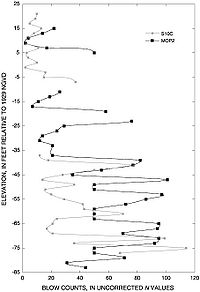
Photo from wikipedia
The inherent variability of soil has a crucial role in reliability-based design, especially for offshore foundations where the variability and uncertainty are more critical due to high costs as compared… Click to show full abstract
The inherent variability of soil has a crucial role in reliability-based design, especially for offshore foundations where the variability and uncertainty are more critical due to high costs as compared to the onshore counterparts. In this study, spatial probabilistic evaluation of the characteristics of offshore/nearshore sea bottom soils is performed based on data of 65 cone penetration tests (CPTs), reaching to 200-m depths in seabed soils, in up to 64 m of water. The types and typical characteristics of sea bottom soils are reported, together with statistical evaluation. A key parameter for random field theory, the spatial correlation length, based on CPT data is obtained for different soil types, using four different autocovariance functions (exponential, squared exponential, cosine exponential and second-order autoregressive). For these purposes, a MATLAB code is developed to take the CPT data, identify individual soil layers, carry out statistical evaluation of the properties of soils and report the vertical spatial correlation length of each layer using four different autocovariance functions. The undrained shear strength of clays in nearshore and offshore soils increases with depth, at rates of 1 to 3 kPa/m. Sands nearshore and offshore have similar relative density that is generally less than 50% (i.e. in loose to medium-dense state). The vertical spatial correlation length based on CPT of all soils is in the range of 0.11 m to 0.27 m, for all four different autocovariance functions, for all CPT cone tip resistances, sleeve friction and friction ratio, and for all shallow- and deep-water soils. The vertical spatial correlation length of nearshore soils is slightly larger than offshore soils. The results add to the scarce data on the spatial correlation length of offshore soils and can be useful for future studies on reliability and risk assessment of nearshore/offshore foundations.
Journal Title: Bulletin of Engineering Geology and the Environment
Year Published: 2019
Link to full text (if available)
Share on Social Media: Sign Up to like & get
recommendations!